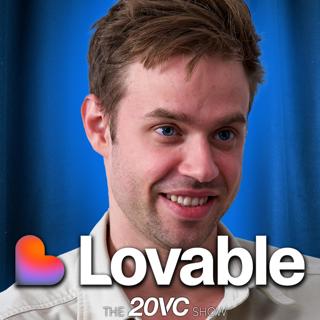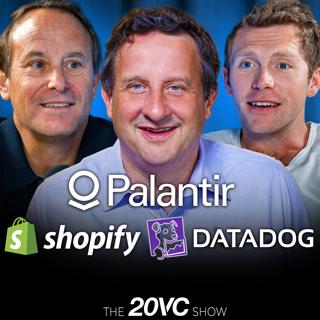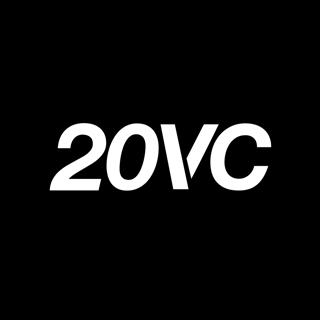
20VC: Databricks at $100BN | Chamath's SPAC Revival: Peak Mania? | OpenAI Staff Cash Out Billions & Sam Altman Will Spend Trillions | CoreWeave's $11B Debt Bet & Nubank's $2.5B Profit Shocker
Agenda: 00:00 – Databricks hits $100B: Bubble or just the beginning? 03:15 – Is Databricks actually undervalued at 25x revenue? 07:40 – Are we on the verge of the biggest IPO wave ever? 11:30 – Can Andreessen's Databricks bet return $30B+? 18:10 – Who really gets rich when mega-unicorns IPO? 19:30 – Is the return of Chamath's SPACs the ultimate bubble signal? 28:00 – Should OpenAI staff be cashing out billions in secondaries? 33:30 – Founder raises $130M… then walks away. Is this the new normal? 36:30 – Nubank's $2.5B profit: The best FinTech in the world? 48:00 – On Running at $15B: Can consumer brands still be VC-backed rockets? 52:00 – CoreWeave takes on $11B in debt: smart bet or ticking time bomb? 1:11:00 – Will AI spend really hit trillions—or is it all hype?
21 Elo 1h 27min

20VC: Lovable CEO Anton Osika on $120M in ARR in 7 Months | The Honest Truth About Defensibility and Unit Economics for AI Startups | The State of Foundation Models: Long Grok, Short OpenAI, Why | Replit vs Lovable vs Bolt: What Happens
Anton Osika is the Co-Founder and CEO @ Lovable, the fastest growing company on the planet. In just 7 months, they have scaled from $0 to $120M in ARR. They have raised over $200M in funding from some of the best including Accel, Creandum and 20VC. Their latest round priced the company at a whopping $2BN. Agenda for Today: 00:00 – Is AI an Arms Race… Or Just a Talent War? 03:45 – How Does Anton Compete with Zuck's $100M Packages for Talent 07:30 – Founder Mode vs. Structure: Can Chaos Scale? 10:15 – The Brutal Truth About Defensibility in AI Startups 13:20 – Unit Economics: Are AI Companies Doomed to Bleed Cash? 17:00 – GPT-5: Game-Changer or Overhyped Disappointment? 20:10 – How Lovable Hit $100M ARR in Just 7 Months? 25:15 – Replit, Figma, Bolt: Which Competitor is the Best? 30:00 – The Security Bombshells No One Talks About 36:40 – Should Anyone Still Study Computer Science? 40:30 – Work-Life Balance Is Dead: Inside Anton's 10x Culture 56:00 – OpenAI, Anthropic, or Grok: Who Wins the AI Wars?
18 Elo 1h 8min

20VC: 15 Term Sheets in 7 Days and Choosing Benchmark | Harvey vs Legora: Who Wins Legal and How to Play When You Have $600M Less Funding | Are AI Models Plateauing Today | Building a 9-9-6 Culture From Stockholm with Max Junestrand
Max Junestrand is the Co-Founder and CEO @ Legora, the collaborative AI powering the next generation of lawyers. Now this is an insane story for many reasons; first, Max turned down a multi-million dollar career in gaming to build Legora. Second, he has raised from the best of the best including Benchmark and IVP. Third, he has scaled the firm with 1/6th of the capital of his closest competitor, Harvey have raised a reported $800M while Legora have raised just $120M. Agenda: 00:03 – From Pro Gamer to AI Founder: How World of Warcraft Shaped Max's Mindset 04:58 – The $5–10M Gaming Career He Walked Away From 07:55 – Are AI Models Plateauing… or Just Getting Started? 10:02 – Swarms of LLMs: The 100x Cost Bet That Could Change Legal Forever 12:00 – Partnering With the Lawyers You're "Killing" 15:00 – How He Cracked Sweden's Hardest-to-Enter Law Firm 21:45 – The $500K Coffee That Saved the Company at YC 30:00 – Closing 15 Term Sheets in 7 Days – Why Benchmark Won 36:00 – Beating a $5BN Rival With a Fraction of the Funding 53:50 – Building a Cult Culture: The 9-9-6 Mentality in Europe
15 Elo 1h 20min

20VC: GPT5: Sam Altman's Masterplan or a Gift To Anthropic | Palantir & Shopify Crush Earnings | Monday & Datadog Perform But Hit Hard by Wall St | Should Perplexity Buy Chrome for $34.5BN |
AGENDA: 00:04 – Was GPT-5 the Biggest AI Letdown Yet? 00:17 – Is OpenAI's Real Target Anthropic's $6B Revenue? 00:22 – Why Anthropic Might Secretly Be Worried 00:28 – The Hidden Business Strategy Behind OpenAI's "Underwhelming" Launch 00:32 – Should Perplexity Really Try to Buy Chrome for $34.5B? 00:35 – The $3B N8N Deal: Genius Bet or Bubble FOMO? 00:38 – Why Datadog's Best Quarter Ever Still Tanked the Stock 00:44 – Palantir's 50% Growth at Scale – Can It Last? Is Palantir Overpriced? 00:53 – Shopify's Ruthless Path to 91% Revenue Growth With 30% Fewer Staff 01:01 – Are Seed and Series A Valuations Now at Dangerous Highs? 01:06 – What Does The Highest Levels of Capital Concentration Mean For Early Stage Founders? 01:15 – Could Palantir Hit a $2 Trillion Market Cap by 2030?
14 Elo 1h 22min

20VC: Figma, Scale, Wiz: Inside Index's Decacorn Factory | Decision-Making, Investment Process, Biggest Lessons, Biggest Misses | Why Gross Margin is a Fallacy at Seed | Never Turn Down a Deal on Price with Martin Mignot, Partner @ Index Ventures
Martin Mignot is a Partner at Index Ventures, the best-performing fund in the world right now. In the last three months, they have sold Wiz for $ 32 billion, sold Scale for $14.9 billion, and IPO'd Figma as the largest investor. In addition to this, they are the largest or second-largest shareholders in Roblox, Revolut, Adyen and Datadog. Agenda for Today: 00:00 – Why Gross Margin is the Biggest Sin in the Early Days 04:50 – Why Most People Shouldn't Become VCs 07:40 – Why it is BS to Suggest the Future of VC is Boutique vs Mega Fund 09:10 – Do Multi-Stage Funds Really Give a S*** About Seed 13:50 – The Founder Trait That Trumps Market Size Every Time 18:45 – How Spotify Still Haunts Index Ventures & What They Learn From It? 28:50 – The Brutal Truth About European vs. U.S. Founders 34:20 – The Case for a European AI Giant (and Who Might Build It) 40:50 – The Return of the 7-Day Founder Work Week 52:10 – Biggest Lessons from Leading Revolut's Series A 56:40 – Betting Against Nick Storonsky? Don't. 1:03:10 – The One Competitor Index Ventures Admires
11 Elo 1h 19min

20VC: The $BN Greenoaks Backed Protein Bar | Hitting $100M Revenues in David's First Year: Lessons & Mistakes | $0 to $600M: The Untold RXBAR Story | Product-Market-Fit, Pricing, Branding: What Every Founder Gets Wrong Today with Peter Rahal
Peter Rahal is the Co‑Founder & CEO of David Protein, the highest protein‑to‑calorie ratio for any protein bar on the market. Peter has raised over $85M from Greenoaks, Dr. Peter Attia and Dr. Andrew Huberman with the latest round valuing the company at $725 million. The company is poised for over $100 million in first‑year revenue. Formerly, Peter co‑founded RXBAR in his mom's basement with a $10k start, growing it into a household brand and selling it to Kellogg for $600 million. poised for over $100 million first‑year revenue Agenda for Today: 00:04 – The One Piece of Advice from My Father That Made $600M 00:07 – Selling Protein Bars from a CrossFit Gym to $2M in Year One 00:12 – Why Raising Money Early Would Have Killed RXBAR's Success 00:15 – Product vs Brand: What Every Brand Gets Wrong Today 00:17 – Why Red Bull is the Best Brand in the World? What Can We Learn From It? 00:20 – Are Brands the New Religion? How Status and Community Really Work 00:27 – The Boiled Cod Stunt: Brilliant Marketing or Massive Waste of Time? 00:35 – Selling RXBAR for $600M: Inside the Decision and the TAM Ceiling 00:40 – $100M Overnight: What Really Changes When You Get Rich 00:44 – The Hidden Costs of Success: Health, Relationships and Obsession 00:47 – Why Peter Doesn't Care What People Think… and Actually Likes Upsetting Them 00:53 – The $10B Plan for David: From Protein Bars to a Portfolio of Brands
8 Elo 1h 6min

20VC: Figma's 250% Pop - The Greatest IPO Mispricing Ever | Meta and Microsoft Blowout Quarters: Broken Down | Cognition Raises at $15BN and Ramp at $22BN | CRV Downsizing and What It Means for LPs and GPs
Agenda: 00:00 – The Worst IPO Mis-Pricing Ever: What Really Happened at Figma 02:30 – Fidelity vs Founders: How Important is Fidelity When Going Public 07:00 – Why Founders Secretly Want a Pop, Even If It Makes Them Look Stupid 10:15 – The Truth Behind the $3B Figma "Left on the Table" 14:00 – Direct Listings vs IPOs: Should Figma Have Gone Direct 23:00 – CEO Compensation is Broken, Brian Halligan Doesn't Hold Back 29:00 – The New Normal: Growth Rounds with Elon-Style Moonshot Packages 33:00 – Is Canva Next? Why Founders Should "Run, Forrest, Run" to the NASDAQ 36:00 – The Case for Going Public: VCs Are a Bigger Pain Than Public Markets 44:00 – Can AI Even Work for SMBs? Why No One's Cracked the Code (Yet) 51:00 – Meta's Monster Quarter: Growth, Cash Burn, and the Real AI Strategy 56:00 – CEO of the Year? Why Jensen Huang Leaves Zuck & Satya in the Dust 1:00:00 – Cognition's $15B Deal & Mass Layoffs: The Most Savage M&A Move of 2025 1:07:00 – Ramp's $22B Raise: Genius Move or Suicide Round? 1:09:00 – CRV Shrinks, Benchmark's Bet, and the Future of Venture Strategy
7 Elo 1h 20min

20Sales: $0-$3.7BN: The Databricks CRO's Playbook to Build the Fastest GTM Engine in SaaS History | How Databricks Beat Snowflake | How To Build a Sales Org of 5,000 and Close $190M Deals with Ron Gabrisko
Ron Gabrisko is the Chief Revenue Officer at Databricks, where he joined in 2016. Under his leadership, Databricks has scaled from $0 to $3.7BN annualized revenue. He has grown the sales team from 0 to over 1,000 globally, leading expansion into enterprise, government, and international markets. Ron previously held senior sales roles at Cloudera and IBM, bringing deep experience in data and AI infrastructure. His tenure at Databricks has been defined by hypergrowth, multi-product adoption, and world-class GTM execution. Agenda for Today: 00:04 – The Databricks Origin Story: Ali, Ben Horowitz & 7 PhDs 00:08 – Ali vs JPMorgan: Turning Down $10M to Stay Cloud-First 00:13 – Prospecting Day: How Ron Scaled the GTM Culture 00:16 – Why Databricks' Pricing Model Was Its Secret Weapon 00:19 – Enterprise vs SMB: The Risky Bet That Paid Off 00:23 – From $2M to $13M ARR: How Ron Built the First Sales Engine 00:29 – Can AI Replace Salespeople? Ron's Brutally Honest Take 00:36 – How to Get Your First Million-Dollar Rep (and Keep Them) 00:42 – The Culture Secret Behind Scaling to 5,000 Sales Reps 00:45 – Why Databricks Waited Until $500M ARR to Go International 00:52 – What Makes a Great Sales Meeting? Ron's Gold Standard 00:58 – The Snowflake Wars: Why Ron Says Databricks Is 5 Years Ahead
4 Elo 1h 15min






















